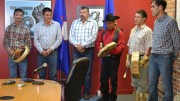For several years Peru has maintained its position as one of the world’s top producers of gold, silver, zinc, copper and lead.
At the national level, President Ollanta Humala, elected in 2011, has welcomed foreign investment that, combined with the abundance of natural resources, has made Peru a favourable destination for mining and extractive sector investments.
Yet, at the local level, mining projects are at a real risk of disruption, delay or cancellation owing to community opposition. Local communities, such as those in the province of Cajamarca, are increasingly opposed to mining by foreign investors because of a lack of consultation on previous projects and a widespread perception that the economic benefits of mining are insufficient to compensate for degradation to the local environment.
The prevalence of bribery and corruption in conducting business adds to the risk of mining in Peru.
President Alberto Fujimori helped stabilize the economy in the 1990s by encouraging foreign investment in the country. One of his accomplishments was building Newmont Mining’s Yanacocha gold mine in Cajamarca.
However, while his economic reforms helped Peruvians access their natural resources, the by-products of such foreign investment were not without consequence and brought crime, drugs and prostitution to the region. The influx of investment did little to improve rural poverty or eliminate racism, and many Cajamarcans did not see their quality of life benefit from the Yanacocha gold mine.
Once the Peruvian economy began to stabilize, Peruvians — and in particular those in the Cajamarca region — attempted to limit foreign investment to protect their land and their people. In Cajamarca, ongoing opposition has resulted in failed relationships between investors and local community leaders, which have lead to protests, disruption and failed investments.
The risks
A number of community groups have gained notoriety in their opposition to how mining is being done in Cajamarca. One prominent group is the Environmental Defence Front of Cajamarca led by Wilfred Saavedra, who has been vocal in decrying the environmental impact of mines. Saavedra’s activism and close working relationship with Gregorio Santos, the regional president of Cajamarca, have frustrated Humala and his government’s economic policies.
A newer and equally influential group is the Front for the Defence of the Interests of Cajamarca. This umbrella group was created by 13 provincial leaders and over 100 municipal leaders during recent protests and has successfully co-ordinated and led labour strikes in cities across Cajamarca.
Other community leaders are advocating for sustainable development in the region, relying upon the newly implemented “Prior Consultation Law,” which requires that foreign investors and developers consult with local communities over the implementation of new projects and how they will affect the local ecosystem.
Cajamarca made international headlines because of the violent protests over mining in the region. Newmont’s proposal to build the Conga gold-copper mine in the province — potentially the largest source of foreign investment in Peru’s history — has been met with significant unrest and opposition by Cajamarcans.
Many local community members feel they do not and would not gain direct, economic benefits from the mining projects. They only see environmental degradation. These concerns are being exacerbated by a mercury spill that occurred some time ago at the headwaters of the rivers that supply the arid region with irrigation and drinking water.
Water supplies have also been greatly compromised with a rising demand for water caused by an increase in population. The result has been reports of neighbouring communities only receiving two hours of water a day because of lack of water.
To highlight the importance of the community’s concerns and to minimize further damage to the environment, Cajamarca was blockaded by the community against Newmont developers for 11 days in November 2011.
President Humala declared a state of emergency and ended the protests, further angering local communities in the process.
The regional Cajamarca government responded by passing a law cancelling the Conga mine project. Both the regional Cajamarca government and local communities are becoming increasingly critical of the national support for foreign investments in the mining sector and its purported community benefits.
As recently as March 19, Cajamarca’s regional vice-president Cesar Aliaga Diaz said in an interview that his local government feels obligated to respond to local concerns in the form of the “036 Ordinance” declaring the Conga project not viable, and protecting the land and water sources on the mine site.
The national government thinks the local government has gone too far, but at the moment the environmental impact study (EIS) is being reviewed by three foreign consultants. The review is specifically concerned with reconstructing four natural lakes into four engineered reservoirs. This would double water storage and help deal with droughts, but opponents say it will needlessly destroy wetlands.
Diaz says he would rather see a new EIS than a hasty review in 40 days of the old one. In anticipation of the soon-to-be-published report, security personnel at the time of writing are stationed in Cajamarca to be prepared for any unrest.
Corruption in Peru’s mining sector is common. While it may be tempting to engage in these “local business practices,” bribery and corruption charges can be laid against foreign companies in Peru. In addition, Canada’s Corruption of Foreign Public Officials Act can impose a five-year jail term and up to a $50,000 fine for individuals convicted of contravening the act, as well as unlimited fines against corporate entities. Similarly, a U.K. company can expose itself to prosecution under the U.K.’s Bribery Act 2010, or the Foreign Corrupt Practices Act in the U.S.
Combining the active opposition to mining projects with the strained governmental relations within Peru and the risks of having to engage in “local business practices” — is the real cost of mining in Peru worth it? Newmont’s developers, the national Peruvian government and the Canadian government certainly think so.
The Remedies
Newmont’s developers and foreign investors have attempted to rectify their earlier lack of consultation with the community and environmental groups by initiating a number of community development projects. These include building reservoirs and irrigation canals that would replace lakes that were destroyed by the project, and by supplying water year-round to the region.
The national Peruvian government recently committed US$1.6 billion to building infrastructure and social development projects in the area. In December, Minister of Transport and Communication Carlos Paredes announced that US$805 million would be invested in upgrading and building new roads in the Cajamarca region. This will not only improve transportation in the region, but provide local communities with much-needed jobs.
The Canadian government is funding a US$15-million project in Cajamarca to enhance the benefits enjoyed by local communities from foreign investments in the extractive sector.
This latter investment may present an entry point for Canadians to engage Cajamarcans in discussion, since consultations with non-governm
ental organizations (NGOs) that are active in the region are necessary. Partnering with reputable agencies is a possible way to demonstrate a genuine interest in community engagement to local communities.
To minimize the risks encountered in Cajamarca, or any other region in which a company invests, foreign investors and developers should take steps to develop a successful program of corporate social responsibility (CSR) by identifying the range of active stakeholders (i.e., political leaders, community groups and NGOs) in the targeted region.
Once identified, it will be necessary to inform the stakeholders of the investor’s interest in implementing a CSR strategy for the mine. Meetings with stakeholders should focus on seeking community input and developing solutions based on local needs and expectations.
— The author is the chief risk officer of IN-D-TEL InternationalTM, a Canada-based political risk consultancy specializing in opportunities abroad. For more information on mining in Cajamarca, Peru or other regions worldwide, please contact IN-D-TEL InternationalTM at hq@indtel.ca, or visit www.indtel.ca.




Be the first to comment on "Commentary: The risks of gold mining in Peru"